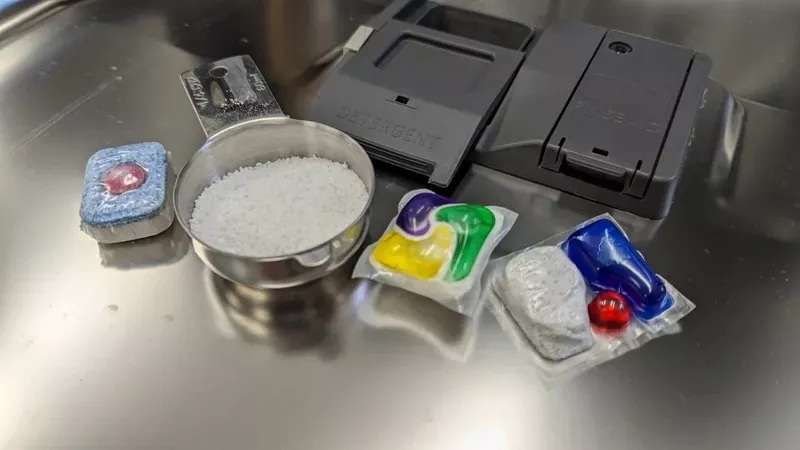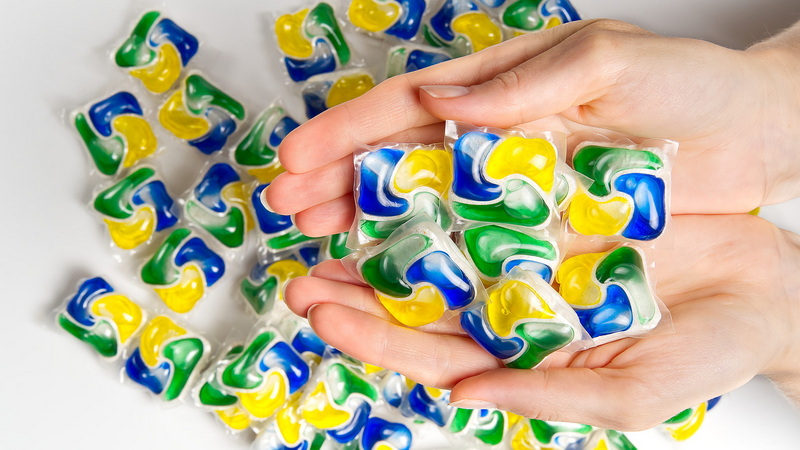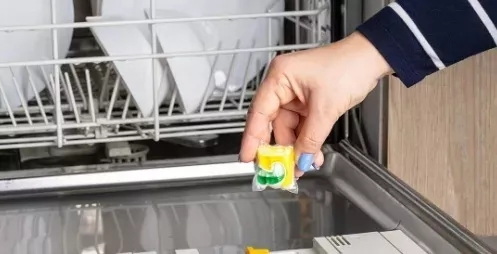Dongguan UFine Daily Chemical Co.,Ltd.
- All
- Product Name
- Product Keyword
- Product Model
- Product Summary
- Product Description
- Multi Field Search
Views: 222 Author: Tomorrow Publish Time: 10-24-2025 Origin: Site











Content Menu
● Understanding How Dishwasher Pods Work
● Common Reasons Your Dishwasher Does Not Use the Pod
>> 1. Improper Placement of the Pod
>> 2. Dishwasher Detergent Dispenser Malfunction
>> 3. Water Temperature Too Low
>> 5. Using the Wrong Cycle Setting
>> 6. Detergent Compartment Blocked or Dirty
● Additional Factors Affecting Pod Use
>> Using Pods with Rinse Aid or Boosters
>> Environmental Conditions and Storage
● How to Troubleshoot and Fix the Issue
>> Inspect the Detergent Dispenser Mechanism
>> Run Hot Water Before Starting the Dishwasher
>> Increase Water Temperature Setting
>> Clean Spray Arms and Filters
>> Use Appropriate Cycle Settings
>> Try Different Detergent Pods
● Recommendations for Maximizing Pod Performance
● FAQ About Dishwasher Not Using the Pod
>> 1. Why won't my dishwasher dispenser open to release the pod?
>> 2. Can cold water affect pod dissolution?
>> 3. How do I know if my spray arms are working correctly?
>> 4. Is it okay to run the dishwasher on eco or quick cycles with pods?
>> 5. Can old or expired pods cause problems?
When you load your dishwasher, using detergent pods is supposed to make cleaning easier. These pods are convenient, pre-measured, and designed to dissolve fully during the wash cycle. However, many users encounter an issue where the dishwasher does not seem to use the pod properly. This problem can lead to dishes not being cleaned effectively and detergent residue left in the machine. In this article, we will explore the common reasons why your dishwasher might not be using the pod, troubleshoot solutions, and provide tips to ensure your dishwasher works as intended.

Dishwasher pods are compact, single-use packets containing the right amount of detergent and cleaning agents needed for one load. They are placed in the detergent dispenser compartment of the dishwasher. During the wash cycle, this compartment opens, and water sprays on the pod, causing it to dissolve and release detergent.
The effectiveness of pods depends on several factors. The pod must be placed correctly, the dispenser must open fully, and the dishwasher must maintain proper water temperature and pressure. If any of these are off, the pod may not dissolve or be used effectively.
A frequent cause is placing the pod incorrectly. The pod should always be placed inside the detergent dispenser, not just loose in the dishwasher or stuck inside a utensil basket. If the pod is placed elsewhere, it might not dissolve correctly or get used during the cycle.
The detergent dispenser door is designed to open at a certain point in the cycle to release the pod. If the door is stuck, broken, or otherwise malfunctioning, the pod will remain sealed inside and will not release detergent into the tub. This can be due to a mechanical failure, electrical problem, or blockage.
Dishwasher pods generally require hot water to dissolve completely. If your water heater is set too low or if the dishwasher isn't heating the water properly, the pod might remain solid. The recommended water temperature for dishwashers is usually around 120°F to 150°F (49°C to 66°C) for optimal results.
Strong water jets are necessary to spray and dissolve the pod. If water pressure is low, the pod might not dissolve as expected. Low pressure can be caused by plumbing problems, clogged filters, or malfunctioning spray arms.
Some dishwasher cycles, such as quick wash or eco modes, use less water and lower temperatures to save energy. These cycles might not provide conditions favorable for the pod to dissolve fully. Using a normal or heavy-duty cycle can help ensure the pod is used correctly.
Residue buildup or food particles can block the detergent dispenser door or prevent it from opening fully. Likewise, if the compartment is dirty, it can prevent proper pod release. Regular cleaning of this compartment is essential.
Not all pods dissolve equally well. If you are using expired, poorly manufactured, or incompatible pods, they might not dissolve properly regardless of dishwasher conditions.
Hard water contains high levels of minerals like calcium and magnesium, which can interfere with detergent effectiveness. It may cause pods to clump or fail to dissolve properly, leaving spots or residue on dishes. Using a water softener or adding rinse aid can improve pod performance under hard water conditions.
When you overload the dishwasher, water and detergent cannot circulate freely around the dishes or inside the detergent compartment. This lack of circulation means some pods might not dissolve fully because they do not get exposed to enough water. For the pod to work properly, load the dishwasher according to the manufacturer's instructions, allowing enough space between items.
Some users combine pods with additional rinse aids or detergent boosters to improve cleaning performance. This can sometimes affect how pods dissolve or release detergent because the chemicals might interact. Make sure to follow product guidelines and avoid mixing incompatible cleaners.
Pods stored in humid or damp environments may absorb moisture, causing them to clump together or start dissolving prematurely. Always store pods in a cool, dry place and keep the container tightly sealed to maintain pod integrity.

Always place dishwasher pods in the detergent dispenser cup inside your dishwasher door. Make sure the compartment is dry and clean before inserting a pod. Avoid placing the pod directly in the dishwasher tub.
Open and close the detergent dispenser manually to check for damage or blockages. Listen for any mechanical sounds or signs that it might be stuck. Consult your dishwasher manual to test or reset the dispenser.
Run the hot water at your kitchen sink to ensure that hot water enters the dishwasher at the beginning of the cycle. This helps the pod dissolve more quickly.
Adjust your water heater to at least 120°F (49°C). Check your dishwasher's owner manual for specific temperature recommendations and ensure the internal heating element is working properly.
Remove and clean dishwasher spray arms and filters periodically to maintain proper water flow and pressure. Clogged spray arms can disrupt pod dissolution.
Select cycle modes that use sufficient water and heat such as normal, heavy, or pots and pans. Avoid quick wash or eco cycles when using pods.
Switch brands or types to test if pod quality is the issue. Use high-quality pods tested for your machine model.
Clean the detergent dispenser regularly with warm water and a soft brush. Check the dishwasher for any buildup or mechanical faults that might impair performance.
- Always use fresh pods and check the expiration date.
- Store pods properly, avoiding humid environments.
- Use rinse aids to reduce spotting and improve drying.
- Avoid mixing pods with other detergent types.
- Follow manufacturer's instructions on loading and cycle selection.
- Periodically descale your dishwasher to prevent mineral deposits.
- Consider installing a water softener if you have hard water.
When your dishwasher does not use the pod correctly, it usually results from issues with placement, detergent dispenser function, water temperature, water pressure, or water quality. By understanding how pods work and addressing these common obstacles, you can restore your dishwasher's cleaning efficiency. Proper placement, appropriate cycle choice, regular maintenance, and quality detergent pods are key to ensuring your dishwasher uses pods effectively and your dishes come out clean every time. Taking care of your dishwasher and its components will not only help dissolve pods correctly but also extend the lifespan of your appliance.

The dispenser may be stuck due to mechanical failure, blockage, or electrical issues. Cleaning the detergent compartment and checking the door latch can help. If the problem persists, the dispenser mechanism may need repair.
Yes, pods require hot water to dissolve fully. Low water temperature prevents the pod from breaking down, leaving detergent residue and leaving dishes unclean.
If the spray arms are clogged or damaged, water pressure drops, and pods don't dissolve properly. Check if they spin freely and clean holes regularly to maintain flow.
Eco and quick cycles often use lower temperatures and less water, which may not completely dissolve pods. It's better to use normal or heavy cycles for pods to work efficiently.
Yes, old or expired pods may clump or fail to dissolve properly. Always use fresh pods stored correctly in dry conditions.